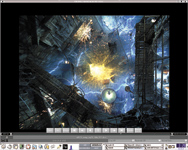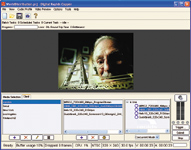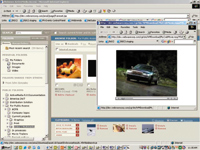
According to Iridas Lin Kayser, FrameCycler includes a suite of analysis tools to judge images, like this effects shot for Van Helsing.
|
Even if the password function is not used at the post house, the tape still has an embedded Pro-Scramble function that will not allow the tape to be played on any consumer D-VHS player.
"People like the familiarity of being able to put a tape in a machine and hit play. You don't have to be a rocket scientist to work it. It sounds like a simple thing, but it's a big deal to a lot of people," notes Librach.
Along with the ability to screen HD material in a system that is familiar to anyone who can operate a traditional VCR, Librach notes the system is also used for SD footage, particularly by MGM, which pulls its SD rough cuts off the Avid so the tapes can be distributed with password protection.

Digital Rapids Copper allows users to send and receive at true wire speed, enabling faster digital dailies sessions
|
A BEVY OF BANDWIDTH
System integrator Video Design Research (www.videodesignresearch.com/) has been working closely with Digital Rapids (www.digital-rapids.com/ ) on solutions that allow for greater network speed and collaboration tools via the Internet. In addition to deploying these third-party systems, Video Design Research works with manufacturers in the design of products, advising them on what features the post market will want included in products.
The first solution is the recently released Copper DMA (Digital Asset Management), which is built upon licensed technology from Digital Fountain. Copper is a software product designed to move large amounts of data over the Internet. Without getting into specifics of how the product works, it essentially allows a standard 10MB connection to truly carry 10MB of data.
"Copper allows you to send and receive at true wire speed, so you can use 100 percent of your available bandwidth," says Michael Flanigan, president of Video Design Research. "Regardless of the Internet traffic or the switcher or the latency you can achieve end-to-end 10MB connection." Included in Copper DMA is a "deliver as" function.

Brick Eksten, CEO.
|
"On one end you can have, for instance, a dpx file and you can choose to have that delivered as any format we support, which is basically every streaming and video format out there," Brick Eksten, CEO of Digital Rapids explains. "So as the needs change depending on the customer you're delivering it to, they can easily download the receiver software so a facility can set up a transfer that automates the entire process from whatever format you have to whatever format the client needs - and it does that in realtime. You can also tell it to deliver as a DVD format and the client receives the file and burns a DVD at their end."
Additionally, Copper DMA has an advanced mode where the client receives an email and it goes back to the server and tells the server where the client is located and allows the client to receive the files. This is particularly useful in the case where a client is in a location with firewalls set up. It opens up a hole in the firewall and allows the client to receive the data.
The second major product from Digital Rapids is Stream Z HD, a turnkey HD ingest, encoding and transcoding box, which was unveiled at IBC this year. "It can take anything in over SDI and in realtime, in hardware format, take whatever the native format is and convert it to any other format and record it to disk," explains Eksten. "So you can back right up against the telecine and pick the formats you want to record and each format has a different set of functions. Then you have your choice of all the other formats you want to encode, whether its Windows Media 9, QuickTime, Real, MPEG, whatever."

Sony Pictures' Jerry Ledbetter: "Formats are going to keep changing and improving."
|
Digital Rapids has built solutions for Ascent Media and The Mill. NBC uses their products for dailies transfers on all of its television productions. And the company's technology was recently used to move all of the effects shots for 20th Century Fox's I, Robot, full film frames transferring between five and 50GB a night.
THE NEED FOR SPEED
In need of a really fast connection, studios like ILM have turned to Media.Net, which has a private high-speed fibre network connected to all the major studios, various post houses in the US and Canada, Europe, Australia and New Zealand, allowing transmission of any resolution.
"For a project shooting in Canada, like the WB's Smallville, they create MPEG-2 files after the footage goes through telecine and send it directly down to editorial in Santa Monica where the Warner Bros. editors cut it and then send it back up to Canada for review and approval," says Paul Weiser, executive VP of marketing and sales of Media.Net.

Sony Pictures is using its proprietary CineShare system, which is built on top of Inscis ActiveMedia product (shown).
|
The company also offers live video collaboration solutions, which have been used on films such as King Arthur and Pirates of the Caribbean. "For King Arthur, the effects were done at Cinesite London," reports Weiser. "We took the output of their system and put a production monitor in director Jerry Bruckheimer's offices in Santa Monica and set up a video conferencing device on both ends so the people in Santa Monica could see the output from Cinesite in realtime. They could then talk to each other via video conferencing and make production decisions. We also have software that allows you to take a tablet and a pen and you can circle things on the tablet, like you see in a telestrator on sports broadcasts, and highlight certain effects or areas of a frame. So it's a live interactive work session as if they were in the same room, and Bruckheimer could see in realtime the changes Cinesite made.
In addition, Media.Net has an HD screening solution where they build screening rooms at the production location and the HD files can be delivered via the private network or on hard drives.
For Man on Fire, shot in Mexico City, Media.Net built a screening room in director Tony Scott's hotel room along with a server with 2TB of storage. Since the hotel was not connected to the private network, hard drives with the footage were delivered to the hotel room and loaded onto the server.
In other cases, such as a project shooting on Martha's Vineyard, Media.Net incorporated satellite transmission. Sometimes, if low rez files are all that's needed it will make use of the Internet. "Whatever the client needs, we'll do an assessment and design a complete solution around it," says Weiser.
While the company has been successful, doing about 120 projects for both film and television in the past three years, Weiser notes, that in the future, production will alter significantly to take advantage of the possibility of a nonlinear workflow.
"We're involved now in everything from production all the way through post," says Weiser. "It's all been fueled by the digital intermediate process. Before, we always referred to the process as a pipeline, where something comes in, goes through and comes out the other end. Today, everything is coming from a central digital repository and then comes out in various forms. It's like the hub and wheel concept. On one spoke it comes out for film release, on another for digital distribution, on another for DVD, on another for VHS, and each one is handled a little differently. So the future innovations will be in moving media, digital asset management and color grading, all supporting this central server as opposed to the traditional pipeline concept of workflow."
WORKFLOW
Altering the workflow to reflect the advantages of digital production as opposed to the traditional way of filmmaking could very well be the mission statement for Iridas (www.iridas.com/) based in Munich, Germany. "We're trying to get a unified digital cinematography workflow that stretches from the set to the post house to the digital intermediate process to the film-out," notes founder/president Lin Kayser.
The first product Iridas released back in 2001 was FrameCycler for review of uncompressed 2K frames out of RAM. This product has enjoyed enormous success with 15,000 seats, so artists in the post house could review any content at their workstation. The one disadvantage was that the number of 2K frames was limited by the RAM. So Iridas, in collaboration with ESC Entertainment - which was then preparing for the two Matrix sequels - released FrameCycler Digital Dailies System (DDS). This plays back direct from disk without any limitations, so an entire movie can be played back at 2K resolution. FrameCycler, Kayser notes, has been used on virtually every big visual effects movie in the past few years.
"On the Matrix sequels, they used this to check the scans directly after they left the scanner, second to check the digital dailies, including live action plates and post produced plates, and then final review before it went out to the film recorder," explains Kayser. "FrameCycler includes a whole suite of analysis tools to judge the image."
At IBC, Iridas and Baytech announced a solution for digital acquisition. "One of the biggest problems with digital cinematography is that the only reliable medium is tape," says Kayser. "The solutions before were to bring disk arrays on set, but that poses a lot of problems. One of the alternatives is Baytech's Cine- RAM recorder, a RAM disk with 4GB to 16GB of RAM and you can use it to record directly to an external storage medium such as a FireWire drive. So you load it from the CineRAM to a laptop and then with our FrameCycler Digital Cinematography Edition you can play back the 2K footage on set. That's been a big problem with digital cinematography... that you can't play it back on set, and the other solutions out there only allow for 1K playback."
In addition, the companion color grading product Speedgrade Digital Cinematography Edition allows users to see on set what the digital footage will actually look like.
"With a digital camera you always have to record in mid tones because that is where there is the most dynamic range, but that's not what the actual look of the footage will be. Also some cameras, like the Viper, record in a raw mode where the output will look green with low contrast, so you can't see anything," notes Kayser. "So with Speedgrade DCE you can do actual color grading on set on a laptop as you stream files off the CineRAM and you can see what the image will look like and manipulate the image, changing color temperature, spill. It's all non-destructive grading so you are just making changes in the metadata. When it goes to the post house, they can enable the metadata changes to see what preview color correction was used on set so they can see what the director wants."
These products, along with the Speedgrade color grading system, has Iridas pushing for a more logical digital workflow.
"Currently, we are caught between traditional filmmaking and post production, which has been digital for a long time, and the digital intermediate process that is fast replacing the chemical process," explains Kayser. "Logically the digital intermediate process should be part of the post process. You have people in post making color decisions every day but they never know what the colorist, who is still part of the intermediate process, will do to the image. In an ideal world you would bring the colorist in and have him time the frames in this nondestructive color grading system [Speedgrade] as they are being worked on. Then after the post process is complete the colorist just has to fine-tune the image before the film out."